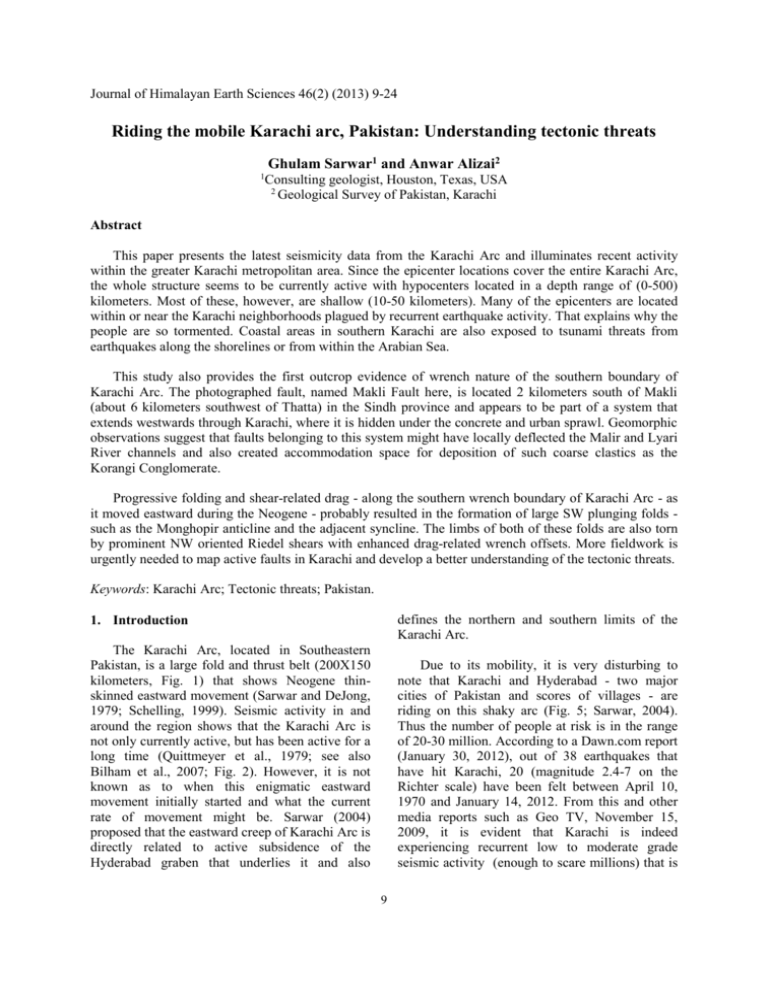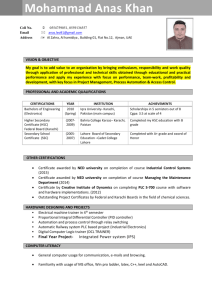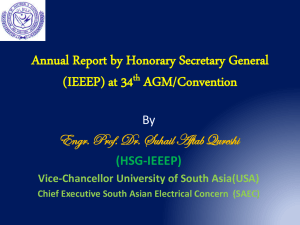Riding the mobile Karachi arc, Pakistan
advertisement

Journal of Himalayan Earth Sciences 46(2) (2013) 9-24 Riding the mobile Karachi arc, Pakistan: Understanding tectonic threats Ghulam Sarwar1 and Anwar Alizai2 1 Consulting geologist, Houston, Texas, USA 2 Geological Survey of Pakistan, Karachi Abstract This paper presents the latest seismicity data from the Karachi Arc and illuminates recent activity within the greater Karachi metropolitan area. Since the epicenter locations cover the entire Karachi Arc, the whole structure seems to be currently active with hypocenters located in a depth range of (0-500) kilometers. Most of these, however, are shallow (10-50 kilometers). Many of the epicenters are located within or near the Karachi neighborhoods plagued by recurrent earthquake activity. That explains why the people are so tormented. Coastal areas in southern Karachi are also exposed to tsunami threats from earthquakes along the shorelines or from within the Arabian Sea. This study also provides the first outcrop evidence of wrench nature of the southern boundary of Karachi Arc. The photographed fault, named Makli Fault here, is located 2 kilometers south of Makli (about 6 kilometers southwest of Thatta) in the Sindh province and appears to be part of a system that extends westwards through Karachi, where it is hidden under the concrete and urban sprawl. Geomorphic observations suggest that faults belonging to this system might have locally deflected the Malir and Lyari River channels and also created accommodation space for deposition of such coarse clastics as the Korangi Conglomerate. Progressive folding and shear-related drag - along the southern wrench boundary of Karachi Arc - as it moved eastward during the Neogene - probably resulted in the formation of large SW plunging folds such as the Monghopir anticline and the adjacent syncline. The limbs of both of these folds are also torn by prominent NW oriented Riedel shears with enhanced drag-related wrench offsets. More fieldwork is urgently needed to map active faults in Karachi and develop a better understanding of the tectonic threats. Keywords: Karachi Arc; Tectonic threats; Pakistan. defines the northern and southern limits of the Karachi Arc. 1. Introduction The Karachi Arc, located in Southeastern Pakistan, is a large fold and thrust belt (200X150 kilometers, Fig. 1) that shows Neogene thinskinned eastward movement (Sarwar and DeJong, 1979; Schelling, 1999). Seismic activity in and around the region shows that the Karachi Arc is not only currently active, but has been active for a long time (Quittmeyer et al., 1979; see also Bilham et al., 2007; Fig. 2). However, it is not known as to when this enigmatic eastward movement initially started and what the current rate of movement might be. Sarwar (2004) proposed that the eastward creep of Karachi Arc is directly related to active subsidence of the Hyderabad graben that underlies it and also Due to its mobility, it is very disturbing to note that Karachi and Hyderabad - two major cities of Pakistan and scores of villages - are riding on this shaky arc (Fig. 5; Sarwar, 2004). Thus the number of people at risk is in the range of 20-30 million. According to a Dawn.com report (January 30, 2012), out of 38 earthquakes that have hit Karachi, 20 (magnitude 2.4-7 on the Richter scale) have been felt between April 10, 1970 and January 14, 2012. From this and other media reports such as Geo TV, November 15, 2009, it is evident that Karachi is indeed experiencing recurrent low to moderate grade seismic activity (enough to scare millions) that is 9 being addressed in this study. During 2009-2012, there have been numerous reports of mild earthquakes from the south of Karachi that terrified the inhabitants in Malir, Landhi, Korangi, Quaidabad, Clifton, Defense, Steel Town, Gizri, Shah Faisal Colony and other areas (Fig. 7). data (Tables 1 and 2) came to us as a list of historic (1902-2013) epicenter coordinates in decimal format. Most of these events were of low magnitude (1-3). We converted the data to degrees, minutes and seconds and plotted on Google Earth maps - displayed in Figs. 5-7. 2. Observations and Discussion As shown on Google map plots (Figs. 5-7), many epicenters are located outside the Karachi Arc and are probably related to triple junction tectonics (Sarwar, 2004) and active fold belt tectonics of the coastal belt. We confine ourselves in this study to Karachi Arc only - located east of the Ornach-Nal Fault (Fig. 1). 2.1. Seismicity In order to evaluate the seismicity of the greater Karachi and surrounding areas, we made a request to the Meteorological Department of Pakistan to provide historic seismicity data. Their THAR RIFT Fig.1. Schematic plate tectonic sketch map showing the Karachi Arc and its regional tectonic framework. Kar Arc: Karachi Arc, KTJ: Karachi triple junction. KK: Khuzdar Knot, MR: Murray Ridge, NPU: Nagar Parker uplift (after Sarwar, 2004). 10 Fig. 2. Geological map of the Thatta area, Sind. Please note the location of figures 3 and 4 on the Makli Fault (denoted by an arrow). From the general distribution of epicenter locations (Fig. 5), it is clear that the entire Karachi Arc is currently active with hypocenters located in a depth range of 0-500 kilometers. Most of the hypocenters, however, are shallow (10-50 kilometers), which probably reflects the thinskinned thrusting (eastward creep) of this arc (Sarwar and De Jong, 1979; Schelling1999). Deep events such as #25 and #28 (500 and 393 kilometers, respectively, Table 1) reflect basement deformation under the Arc. (Uthal Block of Zaigham and Mallick, 2000. Figs. 3, 4 and 7), with respect to Khuzdar. Within the Karachi metropolitan area, there are numerous shallow events (10 - 44 kilometers depth) from 2009-10 time period. Fourteen such events are located between Shah Faisal Colony and Karachi-Hyderabad motorway. Many of these are in close vicinity of the main Karachi airport (Fig. 7) – probably reflecting active shallow deformation heretofore unknown. Events located along the southern end of Karachi Arc reflect shallow deformation as well as deep wrench movements related to the eastward creep of Karachi Arc (Figs. 6-7). Gravity data from the southern Kirthar Belt also provides a hint for basement deformation and supports eastward displacement of Karachi Arc 11 Table 1. List of Earthquakes Recorded/Felt in Karachi/Thatta and surrounding from Nov. 2008 to Apr. 2013. Sr. Date No. 3 15.11.2008 Magnitude Lat N Dec. 3.6 24.19 Long E Dec. 65.29 Depth Region 10 km off Coast of Pakistan 10 km off Coast of Pakistan 10 km off Coast of Pakistan 10 km off Coast of Pakistan 51 km Pakistan 4 25.12.2008 5.5 23.61 64.61 5 26.12.2008 4.1 24.23 64.18 6 29.12.2008 2.8 23.49 64.16 7 01.01.2009 2.4 25.20 66.90 8 01.01.2009 2.1 24.96 67.27 179 km Pakistan 9 02.01.2009 2.1 26.29 65.75 10 km Pakistan 10 02.01.2009 2.0 24.90 67.14 40 km Pakistan 11 03.01.2009 2.6 24.69 67.07 397 km Pakistan 12 03.01.2009 3.0 24.63 66.91 26 km Pakistan 13 14.01.2009 1.2 24.85 67.28 0 km Pakistan 14 17.01.2009 3.2 26.18 66.38 20 km Pakistan 15 23.01.2009 2.1 24.97 67.12 32 km Pakistan 16 26.01.2009 1.4 24.98 67.29 199 km Pakistan 17 26.01.2009 1.9 24.99 66.76 10 km Pakistan 18 27.01.2009 1.3 24.89 67.14 13 km Pakistan 19 28.01.2009 1.9 24.92 67.14 10 km Pakistan 20 29.01.2009 2.4 25.44 67.63 10 km Pakistan 21 29.01.2009 1.7 25.44 67.40 10 km Pakistan 22 30.01.2009 2.2 24.90 67.15 10 km Pakistan 23 31.01.2009 2.1 24.91 67.15 10 km Pakistan 24 01.02.2009 2.2 24.90 67.49 322 km Pakistan 25 05.02.2009 2.2 25.36 67.97 500 km Pakistan 12 Lat/Long (deg-min-sec) 24 11 24.00 / 65 17 24.00 23 38 36.00 / 64 38 38.00 24 13 48.00 / 64 10 48.00 23 29 24.00 / 64 09 36.00 25 11 50.00 / 66 54 00.00 24 57 36.00 / 67 16 12.00 26 17 24.00 / 65 45 00.00 24 53 50.00 / 67 08 24.00 24 41 24.00 / 67 04 12.00 24 37 48.00 / 66 54 36.00 24 51 00.00 / 67 16 48.00 26 10 48.00 / 66 22 48.00 24 58 12.00 / 67 07 12.00 24 58 48.00 / 67 17 24.00 24 50 24.00 / 66 45 36.00 24 53 24.00 / 67 08 24.00 24 55 12.00 / 67 08 24.00 25 26 24.00 / 67 37 48.00 25 26 24.00 / 67 24 00.00 24 53 50.00 / 67 09 00.00 24 54 36.00 / 67 09 00.00 24 53 50.00 / 67 29 24.00 25 21 36.00 / 67 58 12.00 Table 1 contd. Sr. Date No. 26 05.02.2009 Magnitude Lat N Dec. 2.2 26.07 Long E Dec. 67.05 Depth Region 10 km Pakistan 27 07.02.2009 2.0 24.93 67.15 38 km Pakistan 28 07.02.2009 1.8 25.09 67.67 393 km Pakistan 29 11.02.2009 2.1 24.96 67.20 119 km Pakistan 30 16.02.2009 2.1 25.11 67.16 50 km Pakistan 31 16.02.2009 1.9 24.94 67.13 34 km Pakistan 32 17.02.2009 1.9 24.91 67.13 27 km Pakistan 33 18.02.2009 4.6 26.60 66.50 10 km Pakistan 34 20.02.2009 2.1 24.91 67.16 22 km Pakistan 35 20.02.2009 2.4 24.81 67.11 10 km Pakistan 36 20.02.2009 2.9 26.87 65.73 24 km Pakistan 37 24.02.2009 2.6 25.99 67.73 10 km Pakistan 38 24.02.2009 3.4 26.87 67.65 10 km Pakistan 39 27.02.2009 2.5 26.64 66.32 10 km Pakistan 40 02.03.2009 3.9 26.57 65.91 10 km Pakistan 41 06.03.2009 2.7 24.80 67.17 10 km Pakistan 42 07.03.2009 2.8 24.51 67.40 353 km Pakistan 43 07.03.2009 3.6 23.23 65.92 44 07.03.2009 2.6 24.80 67.04 104 km Off Coast of Pakistan 44 km Pakistan 45 17.03.2009 4.9 25.91 67.38 0 km Pakistan 46 18.03.2009 2.8 24.91 67.91 10 km Pakistan 47 19.03.2009 3.1 24.67 66.94 20 km Pakistan 48 19.03.2009 2.3 25.77 67.36 10 km Pakistan 49 22.03.2009 3.9 25.80 67.10 10 km Pakistan 13 Lat/Long (deg-min-sec) 26 04 12.00 / 67 02 50.00 24 55 48.00 / 67 09 00.00 25 05 24.00 / 67 40 12.00 24 57 36.00 / 67 12 00.00 25 06 36.00 / 67 09 36.00 24 56 24.00 / 67 07 48.00 24 54 36.00 / 67 07 48.00 26 36 00.00 / 66 30 00.00 24 54 36.00 / 67 09 36.00 24 48 36.00 / 67 06 36.00 26 52 12.00 / 65 43 48.00 25 59 24.00 / 67 43 48.00 26 52 12.00 / 67 39 00.00 26 38 24.00 / 66 19 12.00 26 34 12.00 / 65 54 36.00 24 48 00.00 / 67 10 12.00 24 30 36.00 / 67 24 00.00 23 13 48.00 / 65 55 12.00 24 48 00.00 / 67 02 24.00 25 54 36.00 / 67 22 48.00 24 54 36.00 /67 54 36.00 24 40 12.00 / 66 56 24.00 25 46 12.00 / 67 21 36.00 25 48 00.00 / 67 05 60.00 Table 1 contd. Sr. Date No. 50 30.03.2009 Magnitude Lat N Dec. 3.5 23.93 Long E Dec. 64.97 Depth Region 241 km Off Coast of Pakistan 19 km Pakistan 51 07.04.2009 2.4 24.90 67.13 52 11.04.2009 2.2 24.92 67.13 15 km Pakistan 53 12.04.2009 2.1 24.84 67.74 10 km Pakistan 54 21.04.2009 3.6 23.92 65.72 55 22.04.2009 2.6 26.45 65.65 93 km Off Coast of Pakistan 10 km Pakistan 56 29.04.2009 3.6 25.99 67.02 10 km Pakistan 57 01.05.2009 3.2 25.81 65.42 10 km Pakistan 58 14.10.2009 2.3 26.57 64.40 59 22.12.2009 2.9 25.74 67.73 10 km Off Coast of Pakistan 10 km Pakistan 60 26.12.2009 2.2 25.53 67.25 10 km Pakistan 61 27.12.2009 2.5 25.07 67.20 10 km Pakistan 62 28.01.2010 2.5 24.94 67.14 24 km Pakistan 63 29.01.2010 2.0 25.61 67.19 10 km Pakistan 64 24.02.2010 3.3 26.95 65.58 10 km Pakistan 65 14.03.2010 2.4 23.42 65.98 66 17.04.2010 3.8 25.45 66.31 10 km Off Coast of Pakistan 10 km Pakistan 67 01.06.2010 2.2 24.85 67.02 10 km Pakistan 68 18.11.2010 2.1 24.97 67.13 19 km Pakistan 69 21.11.2010 3.0 26.93 65.74 10 km Pakistan 70 06.12.2010 2.1 24.49 67.16 10 km Pakistan 71 04.01.2011 4.4 26.63 66.44 10 km Pakistan 72 16.04.2013 7.9 26.65 61.60 76 km Southern Iran *Thankfully indebt to Pakistan Meteorological Department Karachi for providing the data 14 Lat/Long (deg-min-sec) 23 55 48.00 / 64 58 12.00 24 53 60.00 / 67 07 48.00 24 55 12.00 / 67 07 48.00 24 50 24.00 / 67 44 24.00 23 55 12.00 / 65 43 12.00 26 26 60.00 / 65 39 00.00 25 59 24.00 / 67 01 12.00 25 48 36.00 / 65 25 12.00 26 34 12.00 / 64 24 00.00 25 44 24.00 / 67 43 48.00 25 31 48.00 / 67 15 00.00 25 04 12.00 / 67 12 00,00 24 56 24.00 / 67 08 24.00 25 36 36.00 / 67 11 24.00 26 56 50.00 / 65 34 48.00 23 25 12.00 / 65 58 48.00 25 26 50.00 / 66 18 36.00 24 51 00.00 / 67 01 12.00 24 58 12.00 /67 07 48.00 26 55 48.00 / 65 44 24.00 24 29 24.00 / 67 09 36.00 26 37 48.00 / 66 24 00.00 26 38 50.00 /61 36 00.00 Table 2. List of earthquakes recorded /felt in Karachi/Thatta and surrounding areas from Oct 1902-Oct 2008. Sr. No. 73 Date Magnitude Long E Dec. 67.70 Depth 4.8 Lat N Dec. 25.20 24:03:1965 74 40 - 23:07:1965 4.7 26.00 65.10 33 - 75 13:11:1965 5.2 26.20 65.10 22 - 76 11:12:1966 5.1 25.80 68.00 5 - 77 10:04:1970 4.9 25.40 66.80 33 78 14:05:1971 4.4 25.10 68.00 44 79 14:05:1971 4.0 25.20 68.00 33 80 28:01:1972 5.9 26.60 66.30 33 Felt in Karachi. Felt in Thatta. Felt in Thatta. - 81 23:09:1972 4.4 25.40 66.80 10 82 23:09:1972 4.9 25.40 66.70 33 83 24:02:1973 4.5 26.70 66.40 48 Felt in Sonmiani. Felt in Sonmiani. - 84 25:05:1973 4.8 25.50 66.30 29 - 85 05:06:1973 4.8 25.10 68.20 10 - 86 14:08:1973 4.9 25.40 65.60 2 - 87 30:03:1974 4.0 26.70 66.50 33 - 88 04:10:1974 5.7 26.40 66.70 32 - 89 04:10:1974 4.5 26.40 66.80 33 - 90 23:02:1975 4.5 26.30 67.10 96 Felt in Bela. 91 18:02:1981 4.7 26.30 67.40 33 - 92 11:03:1981 4.6 26.30 66.00 7 - 93 25:11:1982 4.9 25.60 67.90 33 94 14:09:1983 4.5 26.40 66.30 43 Felt in Hyderabad. - 95 06:07:1984 5.0 25.60 66.40 33 - 15 Region Lat/Long (deg-min-sec) 25 11 50.00 / 67 42 00.00 26 00 00.00 / 65 05 50.00 26 11 50.00 / 65 05 50.00 25 48 00.00 / 68 00 00.00 25 23 50.00 / 66 47 50.00 25 06 00.00 / 68 00 00.00 25 11 50.00 / 68 00 00.00 26 36 00.00 / 66 17 50.00 25 23 50.00 / 66 47 50.00 25 23 50.00 / 66 42 00.00 26 41 50.00 / 66 24 00.00 25 30 00.00 / 66 17 50.00 25 06 00.00 / 68 12 00.00 25 23 50.00 / 65 35 50.00 26 41 50.00 / 66 30 00.00 26 23 50.00 / 66 42 00.00 26 23 50.00 / 66 47 50.00 26 18 00.00 / 67 05 50.00 26 18 00.00 / 67 24 00.00 26 18 00.00 / 66 00 00.00 25 36 00.00 / 67 54 00.00 26 23 50.00 / 66 17 50.00 25 36 00.00 / 66 24 00.00 Table 2 contd. Sr. No. 96 Date Magnitude Long E Dec. 66.20 Depth 4.8 Lat N Dec. 26.80 02:10:1984 97 33 - 02:10:1984 5.2 26.90 66.20 7 - 98 10:10:1985 5.0 24.90 67.40 99 17:12:1985 5.0 24.90 67.40 33 100 20:12:1985 4.8 24.90 67.40 33 101 06:01:1986 4.9 26.70 66.20 33 Felt in Karachi. Slight damage was caused at steel Mills, Port Qasim and in Karachi. Felt in Karachi, slight damage to some buildings in Karachi area. Felt in Karachi. - 102 12:03:1987 4.2 26.60 68.50 33 - 103 02:08:1987 4.3 26.90 66.40 33 - 104 25:04:1989 4.7 26.50 67.50 33 Pakistan. 105 21:01:1992 5.6 26.60 67.20 33 106 28:03:1992 4.9 26.60 66.70 33 107 22:01:1996 3.9 26.40 66.90 33 108 11:11:1996 4.1 25.00 66.70 33 109 20:12:1996 4.0 25.00 66.60 18 110 09:10:1997 3.3 25.00 66.60 33 Felt at Dadu Sindh and adjoining areas. Considerable damages were reported in Dadu. Bela, Balochistan. Bela, Balochistan. Felt in Karachi & Hyderabad. Felt in Karachi. Felt in Karachi. 16 Region Lat/Long (deg-min-sec) 26 48 00.00 / 66 12 00.00 26 53 50.00 / 66 12 00.00 24 53 50.00 / 67 24 00.00 24 53 50.00 / 67 24 00.00 24 53 50.00 / 67 24 00.00 26 41 50.00 / 66 12 00.00 26 36 00.00 / 68 30 00.00 26 53 50.00 / 66 24 00.00 26 30 00.00 / 67 30 00.00 26 36 00.00 / 67 12 00.00 26 36 00.00 / 66 42 00.00 26 23 50.00 / 66 54 00.00 25 00 00.00 / 66 42 00.00 25 00 00.00 / 66 35 50.00 25 00 00.00 / 66 35 50.00 Table 2 contd. Sr. No. 111 Date Magnitude Long E Dec. 66.50 Depth Region 4.1 Lat N Dec. 25.00 17:03:1998 - 18:08:1998 3.9 25.00 66.70 116 113 16:08:1999 4.7 26.00 67.30 33 114 05:05:2008 4.4 26.90 65.60 10 Felt in Karachi. Felt in Karachi. Felt in Dadu in Sindh. Felt in Awaran, Balochistan. 112 Lat/Long (deg-min-sec) 25 00 00.00 / 66 30 00.00 25 00 00.00 / 66 42 00.00 26 00 00.00 / 67 17 50.00 26 53 50.00 / 65 35 50.00 *Thankfully indebt to Pakistan Meteorological Department Karachi for providing the data 2.2. Boundary wrench fault exposure This fault, named Makli fault here, is probably one of many hidden in the marsh that runs along the southern tectonic boundary of Karachi Arc. This part of the road runs east west and cuts into a rolling landscape made of openly folded and deformed Eocene Laki Limestone. Along the southern wall of the road cut, one can see prominent sub-horizontal slickensides carved into a highly fractured and brecciated creamcolored carbonate, indicating perhaps a shallow depth of deformation (Figs. 3-4). The southern boundary fault zone of Karachi Arc runs east west along the southern edge of Karachi - or through Karachi - and heads towards Makli-Thatha area where a small part of it is exposed as a wrench fault cutting through folded and brecciated Laki Limestone of Eocene age (Fig. 3). This wrench fault (right lateral?) is well exposed (latitude 24*43' N and longitude 67*53' 25"E) along the Sajawal bypass road cut just south of the great necropolis of Makli Hill (2 kilometers from Makli) near Thatha. Fig. 3. Sub-horizontal slickensides on the vertical surface of Makli fault that runs along the hammer to the horizon and tears through the Eocene Laki Limestone. Note brecciated character of the rock. Sajawal bypass road cut, near Thatta. (View looking east). 17 Fig. 4. Makli fault surface showing sub-horizontal slickensides on brecciated Laki Limestone outcrop (along the white arrow and to its right). The photographs in figures 3 and 4 provide the only known surface evidence of wrench movement along the southern edge of Karachi Arc so far - first defined by Sarwar and DeJong (1979) over 33 years ago. It now appears that this boundary may be getting more active towards Karachi - as expressed by media reports and evidence of recurrent seismicity presented above (Tables 1 and 2). However, the exact location and nature of this boundary within the metropolis of Karachi is still not understood. Additional thoughts on that are as follows: work at best, until it is corroborated by field checks for physical damage to infrastructure and buildings. 2.3. Deformation in greater Karachi area Faults, currently active or not, may control drainage and force the streams to change course, at least for some distance, as they encounter fault traces. This is due to topographic, lithologic and structural contrasts across the fault zones and is commonly observed around the globe (see Sarwar and Bohlinger, 2005; for example). Strange deflections are indeed displayed by both the Malir and Lyari Rivers as they flow through Karachi, as follows: Karachi, like any other mega-city, is a jungle of concrete that entirely covers all fault traces. Visible physical damage has been poorly documented so far. Mahmood and Shaikh (2008) investigated the “sinking” of a water tower in 2006 near Clifton area and speculated about liquefaction due to mild earthquakes, without presenting any photographic evidence. Only more diligent fieldwork (checking for physical damage to infrastructure and buildings) and geophysical techniques might help locate the active faults. In the absence of that, an examination of river geomorphology may provide some insights. However, this has to be taken as educated guess The Malir River (Figs. 2 & 5) flows southwest toward Karachi until it takes a westward turn north of Quaidabad and intersects Shahrah-eFaisal. Then, strangely it follows an almost westnorthwest track south of the shah Faisal Colony, until it turns to southwest again and then south near Kashmir Colony. It is suspected that the river track between Quaidabad and Manzoor Colony might be influenced by an east west oriented fault or faults. Thus the Mehran-Korangi industrial area, which is filled by the Holocene (?) Korangi conglomerate (Figs. 7-8; Qureshi et al, GSP map, 2001) would be on the downthrown side of this fault that probably created the accommodation 18 space for deposition of these coarse clastics. The Malir River finally turns to south-southeast, before joining the Arabian Sea, and this turn might also be structurally controlled (Figs. 7-8). side of a fault - with the areas south of Shahrah-eFaisal being on the down thrown side. It is noteworthy that many of the areas along and south of the suspected Malir-Lyari Rivers fault zone are more or less the same areas where earthquake reports keep coming from: This correlation is highly intriguing (Fig. 7). The Lyari River follows the eastern flank of the Monghopir anticline all the way to the sea. The southern most outcrop of the nose of this fold is clearly visible on satellite photographs between the Hub River road and the PAF Masroor Road. This anticline and the adjacent syncline both plunge to the southwest. Both of these large folds are cut by numerous northwest trending wrench faults (such as the Sona Pass fault) between Monghopir and the southwestern tip of the map (Figs. 6-9). Numerous epicenters are located both to the east and west of these folds (Figs. 5-7). From near Abdullah Gabol Goth, the Lyari River (Figs. 7-8) flows to the south, but follows a southwest course along Ayaz Town, Gulshan-eIqbal, Hassan Square and Hasan Auliya areas. Then, it also seems to be dragged to westnorthwest as it goes by Golimar-Sher Shah area (Fig. 7). This might possibly be due to an east west oriented fault which might be the westward extension or splay of the Malir River fault. If the Malir and Lyari faults are connected, the entire area between the two rivers could be in trouble. The Mazar-e-Quaid, PECHS, Hill Park and the main airport areas are probably all in faultaffected areas. The Hill Park may not be just a topographic high - it might be on the up thrown Fig. 5. Earthquake epicenter plots for the time period 1902 -2013. The first number refers to the list numbers on Tables 1and 2 whereas the second number represents depth of hypocenter in kilometers. Due to scale limitations, not all the dots have been labeled. Note location of Fig. 6. (Source: Tables 1and 2. Pakistan Meteorological Department, June 2013) 19 Fig. 6. Earthquake epicenter plots for the time period 1902-2013. The first number refers to the list numbers on Tables 1and 2 wheras the second number represents depth of hypocenter in kilometers. (Source: Pakistan Meteorological Department, June 2013) Fig. 7. Earthquake epicenter plots for the time period 1902-2013. The first number refers to the list numbers on Tables 1and 2 whereas the second number represents depth of hypocenter in kilometers. The Red Crosses represent neighborhoods plagued by recurrent seismic activity, usually of low magnitude - as reported by media. See text for discussion. (Source: Pakistan Meteorological Department, June 2013). 20 Fig. 8. Schematic view of the active southern tectonic boundary of Karachi Arc. Note the location of Malir River (MR), Liary River (LR) and Korangi Conglomerate (KG) on the down side of the probable Malir River fault (MR). This is perhaps part of a fault zone (thick wavy red line) that forms this tectonic boundary which runs west to east from the SW tip of this map to Thatta and beyond. Right lateral movement and drag along this tectonic boundary - caused by eastward creep of Karachi Arc (red arrow) - could have modified folds like the southwest plunging Monghopir Anticline and induced all the wrench faults shown to the west of this large fold. See figure 9 please. From our data control (Tables 1 and 2, Figs. 5-7) representing a relatively short length of time (1902-2013), it is hard to say what the relationship might be between the observed seismicity (or long term seismicity) and the suspected Malir–Liary river faults at depth – especially when we do not have any knowledge of the actual fault traces and their geometry in three dimensions. The fact that there are numerous hypocenters (depth range 0-44 kilometers; Figs. 6-7) on all sides of the deflected river segments makes it highly probable that there are numerous hidden unmapped faults throughout the greater metropolitan area and beyond that need to be mapped. The Karachi arc seems to have evolved as a thin-skinned eastward mobile system of thrust faults and fault propagation folds with the main decollement located at a depth of 2-4 kilometers (in the shale of Goru Formation; Sarwar & DeJong, 1979; Schelling, 1999), but deeper levels also seem to be involved – as suggested by deep hypocenters (Tables 1and 2; Figs. 5-7). 2.4. Folds along southern wrench boundary The Monghopir anticline has been interpreted as a complex fault bend fold type structure (related to a west dipping blind thrust. Niamatullah and Imran, (2009), that developed during the Neogene eastward movement of the Karachi Arc. Many of the northwest trending wrench faults, cutting across the two folds, can be interpreted as modified Riedel shears showing enhanced offsets induced by drag along the southern tectonic boundary of the Karachi Arc. However, others seem to be late as they clearly cut across and offset smaller folds. The The cluster of 13 epicenters between the Malir River and the Hyderabad motorway seems to be hinting at active shallow deformation – probably buckling (?) at 10-27 kilometers depth in that area. Whether this is going to be another southwest plunging fold - like so many others in the southern Karachi Arc – is not known (Figs. 6-7). 21 same drag might be responsible for the growth, southwest plunge and the map view curvature of the fold axial traces, as explained in figures 8-9. These folds and faults, therefore, have formed as relatively small structures (as compared to the mother Karachi Arc) along the wrench boundary of Karachi Arc. The relation between the above mentioned folds and faults to current seismicity is not clear. Most of the epicenters are located east of the Monghopir Anticline and Sona Pass fault (Figs. 6-7), so one gets the feeling that the stress regime, that had induced such structures, was different from the one responsible for the current seismicity. Things seem to have changed in ways to be determined. Thus the cluster of epicenters in the Airport - Gulshane Iqbal Malir area is enigmatic and detached from the Monghopir anticline that probably represents an older episode of deformation. 3. Rate of eastward creep of Karachi arc: some food for Thought We can try to get some feel for the rate of eastward creep of the Karachi Arc from recent history of the area, as follows: The modern town of Bhanbore, located 64 kilometers east of Karachi, is at the southern edge of Karachi Arc. Bhanbore also represents the archeological site that some scholars identify with Debal - the port where the Arab general Mohammad Bin Qasim landed in 712 AD. It is believed that the port city of Debal flourished in the 8th century AD and the Indus River ran through it on its way to the sea located just to the south. It is, however, possible that Debal was located at the mouth of an inlet at the sea, and not necessarily upstream by the river. If the Indus River once ran through the port of Debal, it no longer does so. Today, the river is located about 45-50 kilometers east of the museum at Debal (Bhanbore), and tightly wraps around the front end of Karachi Arc as if being shoved to the east by its mobile front. Does this mean that the river has moved at a rate of 34-38 meters per year since 712 AD? If that seems to be unlikely then we need to find another explanation. The question then becomes: was there ever a tributary of Indus that once flowed south from the Manchhar Lake to Bhanbore, and has somehow vanished due to recent uplift of Karachi Arc? Or, may be Debal was not a river port at all, but instead a port at the seashore. Only further work can answer such questions. Fig. 9. Progressive Neogene evolution of the southwestern Karachi Arc. Over time 1-3, shear related drag align the southern wrench boundary could create folds with SW plunge- like the Manghopir Anticline (MA) and wrench faults like Sona Pass (S) that tear through the fold limbs. The curvature of the axial traces of folds developed due to deformation in map view as the folds of central Karachi Arc moved east ward (Large arrows) dragging their southern ends in an episodic fashion over time. This schematic model implies many more hidden NW, NE and E-W oriented faults on land and in the sea. High resolution satellite photographs of the area do show many such faults. 4. Global warming and Karachi From glacial melting in the high mountains to Monsoon flooding and land loss due to sea encroachment in southeast Pakistan, Global 22 Warming has been blamed as the culprit. According to a new press release (no. 12-051, March 19, 2012) by the US National Science Foundation, sea level could rise by another 2-3 feet during this century and by as much as 70 feet in the following centuries. Just imagine what could happen to the southern half of Karachi and other coastal areas around the world. thousands of buildings and bridges in Karachi and Hyderabad have been poorly built and cannot absorb a serious jolt. Even the subsurface electrical and gas lines are not worry free, so fires can burn through the rubble (remember Kobe earthquake in Japan, 1985). We are a nation ill prepared for any mega-disaster as the 2005 Kashmir earthquake and the more recent massive Indus floods have painfully demonstrated. To make matters worse, the relative sea level rise in southern Karachi may actually be exacerbated by tectonic subsidence, if the epicenters are hinting at faulting at multi-levels. Such areas and other low lying areas (like Clifton, Kaimari, Defense, Korangi and Landhi), especially those artificially built by dumping debris in the sea, are also at higher risk for earthquake-triggered tsunamis generated elsewhere along the Arabian sea margins or from within the basin (Owen Fracture Zone-Murray Ridge). This danger can and should be monitored at sea. It is also our hope that these words will encourage the resident geoscientists of Karachi to follow up on the ideas expressed here and see if they can be tested and improved upon - or otherwise rejected in favor of better ideas as supported by evidence. 6. Conclusions 1. Historic epicenter data plots indicate that the entire Karachi Arc and surrounding areas are seismically active with hypocenters ranging in depth from 0-500 kilometers, which probably signifies active deformation at multi-levels from shallow to deep in the basement. Many of the recent epicenters are located within or close proximity to parts of Karachi plagued by recurrent earthquake activity, which explains why the people are so tormented. 2. For the first time ever, an exposure of the southern wrench boundary fault zone has been photographed near Makli where brecciated Laki Limestone of Eocene age outcrops in a road cut. This boundary fault zone heads west toward Karachi that seems to be currently suffering from a substantial amount of stress and deformation as indicated by numerous seismic jolts in recent years, and a number of historic epicenters as proof. 3. Geomorphic observations suggest that faults belonging to this system might have locally deflected the Malir and Lyari River channels and also created accommodation space for deposition of certain coarse clastic rocks such as the Holocene (?) Korangi Conglomerate. Such faults may or may not be currently active as our current seismicity data is too time-restricted to answer such questions. 4. The folds and faults (including Riedel shears) along the southern end of Karachi Arc seem It is emphasized again that diligent fieldwork is needed to find and map the active faults through Karachi. Also, there can possibly be some other causes for part of the observed seismicity in Karachi, such as natural settling due to groundwater withdrawal, compaction of recent sediments, and especially the man made “land additions” near shore. Due to lack of data, we leave all that for others to ponder. 5. Final remarks We sincerely hope that this humble effort raises awareness about the seismic threats of Karachi Arc and helps develop a better understanding of its tectonic framework and active faults, especially in and around the urban areas. It is hoped that appropriate steps will also be taken by the authorities to assess the problem and devise strategies to deal with it. It is not a question of if but when. Doing nothing is not an option. Severe jolts may strike at any time, so what is needed is a better understanding of the kinematics and dynamics of the Karachi Arc, strict enforcement of building codes, a plan to deal with big disasters and allocation of resources on a priority bases. That way we can hope to minimize the damage when a large earthquake does strike. Let there be no doubt that most of the hundreds of 23 to have been modified due to shear related drag caused by its eastward tectonic creep in the Neogene – in an evolutionary episodic fashion. The rate of such tectonic displacement is not known. 5. Evolving global warming trends pose special threats to the low-lying areas in the south of Karachi and may magnify ill effects of any tsunamis generated elsewhere in the Arabian Sea basin. shocks and liquefaction threat to DHA and Clifton areas. Sind University Research Journal, 40, 1-8. Niamatullah, M., Imran, M., 2009. Structural geometry and tectonics of southern part of Karachi Arc – A case study of Pirmangho and Lalji Area: AAPG search and disc. Article # 50581 (2012). Adapted from oral presentation at PAPG Annual Technical Conference, Islamabad. Quittmeyer, R.C., Farah, A., Jacob, K.H., 1979. The seismicity of Pakistan and its relation to surface faults. In: Farah, A., DeJong K. (Eds.), Geodynamics of Pakistan, Geological Survey of Pakistan, Quetta, 271-284. Qureshi, I.H., Shah, S.A.A., Tariq, M.A., Khan, M.S., Ahsan, S.N., Akhtar, M.J., Pasha, M.A., Khan, I.A., Khanzada, M.I., 1991. Geological map of Karachi area, Sindh, Pakistan. Geological Survey of Pakistan. Sarwar, G., Bohlinger, R., 2005. No active fault problems in Louisiana? Gulf Coast. Association of Geological Societies Transactions, USA, 55, 734-739. Sarwar, G., 2004. Earthquakes and the NeoTectonic Framework of the KutchHyderabad-Karachi Triple Junction Area, Indo-Pakistan. Pakistan Journal of Hydrocarbon Research, 14, 35-40. Sarwar, G., DeJong K.A., 1979. Arcs, Oroclines, Syntaxes: The curvature of mountain belts in Pakistan. In: Farah, A., DeJong, K. (Eds.): Geodynamics of Pakistan. Geological Survey of Pakistan, Quetta, 341-349. Schelling, D.D., 1999. Frontal structural geometries and detachment tectonics of the northeastern Karachi Arc, southern Kirthar Range, Pakistan. Geological Society of America (Special Paper), 328,287-302. Zaigham, N.A., Mallick, K.A., 2000. Bela ophiolite zone of southern Pakistan. Tectonic setting and associated mineral deposits, 112, 478-489. Acknowledgements We thank Dr. Imran Khan, the Director General of Geological Survey of Pakistan (GSP), for the permission to publish this study and the map of Makli area. We are indebted to Mr. Ghazanfar Abbas, Deputy Director General (now retired) of Karachi office (2006) and Mr. Sadaqat Jafri, Director GSP (2006), for organizing a seminar on the seismic hazards of the area in May 2006 where the first author and several local geoscientists presented their ideas. The GSP also provided transportation to visit the Makli area. The ideas expressed here, however, are not necessarily those prevailing at the GSP. The first author takes full responsibility for most of them. The Meteorological Department of Pakistan is thanked for furnishing the seismicity data used in this study. Google Earth enabled us to plot and present data on their wonderful maps that convey meaning so beautifully. Finally, we are indebted to a couple of anonymous reviewers who made some helpful suggestions. References Bilham, R., Lodi, S., Hough, S., Bukhary, S., Khan, A. M., Rafeeqi, S.F.A., 2007. Seismic hazard in Karachi, Pakistan: Uncertain past, uncertain future. Seismological Research Letters, 6, 601-613. Mahmud, S.A., Shaikh, S.A., 2008. Earthquake 24







